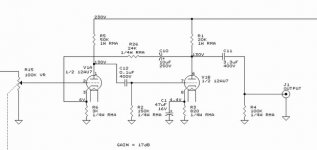Depends on your sound preferences. To me it's a horrendous, badly designed high-feedback circuit. But some like the way it sounds.
Hi there.........the way to the <bootstrap> concept is a good one, a little modification and one has a real bootstrap (far better than using two single R/C coupled stages) the dummy nicely raising the input impedance...and can take a good overload.
I currently use 2 xEF86's (1st in triode config and second pent). This circuit config has excellent overload capacity with high inp Z and high feedback of about 35dB. THD is very low throughout audio pass band as is noise <75dB below 1volt. Sim results with ECC83's except noise is higher. As gain/perfomance /BW is vastly improved there can be the risk of HF positive feedback if gain is too high or from crummy layout . Best results, use screened pentodes instead of naked triodes as HF response is much higher.
The 20KHz perfmance with a good layout should expect av <0.1% THD at the 10V rms output level, then into cathode follower. At lower levels the THD drops proportionally.
keep at it
rich
I currently use 2 xEF86's (1st in triode config and second pent). This circuit config has excellent overload capacity with high inp Z and high feedback of about 35dB. THD is very low throughout audio pass band as is noise <75dB below 1volt. Sim results with ECC83's except noise is higher. As gain/perfomance /BW is vastly improved there can be the risk of HF positive feedback if gain is too high or from crummy layout . Best results, use screened pentodes instead of naked triodes as HF response is much higher.
The 20KHz perfmance with a good layout should expect av <0.1% THD at the 10V rms output level, then into cathode follower. At lower levels the THD drops proportionally.
keep at it
rich
- Status
- Not open for further replies.

